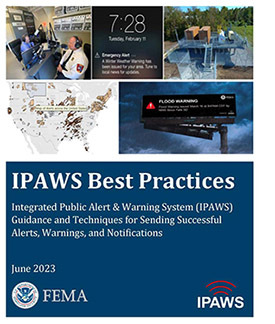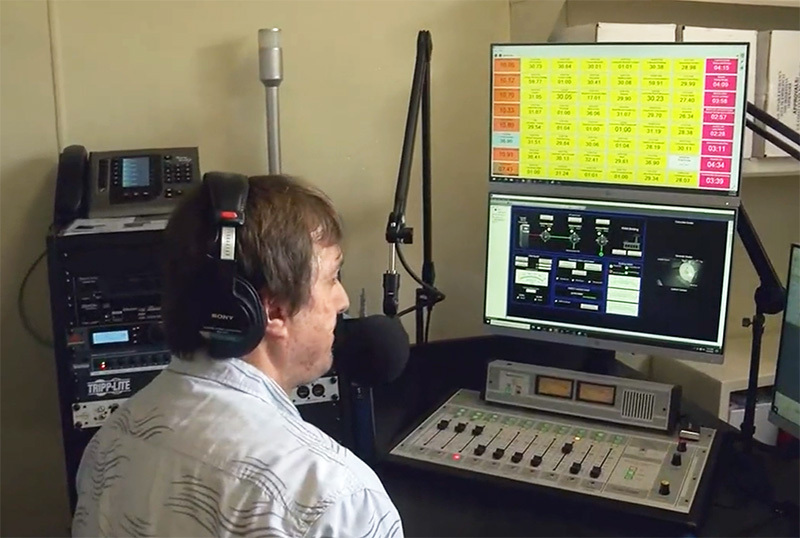|
IPAWS National Test Success
2023 Users Conference
Alerting On Behalf
TSSF YouTube Playlist
WEA Demo App
Best Practices Guide
TSSF vs. Vendor Support
Cross-Jurisdictional Alerting
New NPWS Station in Hawaii
WEA Via Satellite
Coming Events
Webinar Recordings
IPAWS Welcomes New Alerting Authorities
IPAWS National Test Success

FEMA, in coordination with the Federal Communications Commission (FCC), sent the test nationwide via Wireless Emergency Alerts (WEA) to mobile phones and via the Emergency Alert System (EAS) to radio and TV stations and cable TV, at approximately 2:20 p.m. ET on Oct. 4.
FEMA is conducting a survey to help capture data about the geographic reach of the WEA test. The results will help FEMA, the FCC and public safety officials to enhance and expand WEA further.
|
The final determination of population reach for the EAS test will come from data collected by the FCC's EAS Test Reporting System. FEMA and the FCC will analyze the data and share results when they are available in approximately four months.
The WEA portion of the test included Additional Details, supplied from Apple servers to iOS devices. Click or tap the image at left to view. IPAWS Tip #47 described this new capability.
Return to top
2023 IPAWS Users Conference

Your IPAWS team thanks our nearly 1,000 attendees and ten presenters who helped make the 2023 IPAWS Users Conference a success!
We will notify you when the conference recordings and slides are available. Watch your email and the Users Conference page on the IPAWS website for announcements.
|
Return to top
Alerting On Behalf
FEMA's Office of National Continuity Programs and the IPAWS Office have established a new Alerting on Behalf (AOB) policy that will allow us to assist you with building capacity to issue timely alerts and warnings to the public through the planning and implementation of alerting resources and capabilities.
What is the AOB policy?
The AOB policy will allow the IPAWS Office to selectively issue a public alert on behalf of state, local, territorial, or tribal Alerting Authorities (AAs) when all other means to issue an alert have been exhausted. The AOB policy relies on execution and adherence to internal state, local, tribal and territorial policies, procedures and protocols prior to making a request for FEMA to issue an alert on behalf of any alerting official.
The AOB policy encourages AAs' emergency management departments and agencies to establish an internal Alert Escalation Process that ensures continuity of alerting functions within their communities.
Who does the AOB policy affect?
The AOB policy applies to state, local, tribal and territorial AAs who have a current signed IPAWS Memorandum of Agreement.
Why is the AOB policy important?
IPAWS core support functions include assisting AAs with issuing alerts. However, in the absence of clearly articulated policy, procedures and protocols, issuing alerts on behalf of an alerting official has its risks.
Determining the validity of a request, authentication of the requestor, and ensuring the state's, tribal and territorial alert and warning governance structure is followed will reduce the risk of errant messages being sent to the public from unauthorized actors and ensure awareness at all levels.
When will the AOB policy be implemented?
The AOB policy will be implemented on Oct. 23, 2023. The IPAWS Office will then hold educational webinars to share more information about the AOB policy and how to establish or strengthen alert escalation processes.
Return to top
IPAWS TSSF YouTube Playlist
Visit the IPAWS Technical Support Services Facility (TSSF) YouTube Playlist, where you can view video guidance on IPAWS Best Practices, sending effective public alerts, and visiting the TSSF. For example, check out the WEA 90/360 Characters Best Practice video.
Return to top
WEA Demo App

We recently launched an app that allows IPAWS Alerting Authorities to view their test WEAs sent in the TSSF Environment.
When a test WEA is posted, the app will sound and display the WEA on your mobile device. Alerting Authorities will be able to view 90 and 360-character WEAs in both English and Spanish.
|
You can see a brief video on the WEA Demo App on YouTube at this link.
The WEA Demo App can be useful when performing demonstrations, training and exercises and to evaluate your WEA messages and message templates.
Messages received on this app are those sent to the demonstration environment. We encourage you to test real-life scenarios while using good testing language. Using the word TEST in your message is the best practice.
To gain access to the app, send an email to fema-ipaws-lab@fema.dhs.gov with Subject: WEA Demo App Access Request. Include the following:
- Requester's name
- Agency name
- COG ID
- Agency email address (this email address will be used as your username)
- Device you will use to download the application (Apple iOS or Android)
Please allow three business days for us to process your request and send your instructions and login information.
Return to top
Get the Best Practices Guide
 |
|
The IPAWS Best Practices Guide is available for download from the FEMA IPAWS website at this link.
This guide was developed for Alerting Authorities. It provides guidance, recommendations and instruction on the use of IPAWS and sending successful alerts.
Return to top
|
TSSF vs. Vendors
The Technical Support Services Facility assists with issues involving sending IPAWS alerts. However, there are some very specific vendor or IT-related issues that require Alerting Authorities to refer to other sources for support.
Some concerns that may require assistance from your IT department or vendor are:
-
Your agency-specific website requirements or access to your vendor software
- Creating and resetting your vendor software passwords to access the system
- IT restrictions that your agency may have in place
- Knowing the mass notification features of the vendor software vs. IPAWS
- Scheduled and unscheduled outages/updates of the vendor software
If you are unsure of whom to contact, reach out to the TSSF at 1-84-IPAWSLAB.
Return to top
IPAWS Cross-Jurisdictional Alerting
Do you have someone who will send an alert on your behalf, in an instance where you weren’t able to? IPAWS encourages you to build and develop a contingency plan with your neighboring jurisdictions.
To participate in cross-jurisdictional alerting, both entities will need to have a Public Alerting Authority (PAA) application on file reflecting permissions necessary to alert across the jurisdictional boundary. Visit the IPAWS Users' Portal to create or update your PAA application today!
Return to top
FEMA Unveiled Hawaii's New Emergency Broadcast Facility

Earlier this summer, a new state of the art Primary Entry Point (PEP) facility was unveiled on Oahu, just before the start of hurricane season for the region.
|
This emergency broadcast facility is designed to continue operating before, during, and after natural disasters such as hurricanes, earthquakes, tornadoes and tsunamis. PEP stations serve as the primary source of initial broadcasts for a national alert.
This PEP station along with 76 other PEP stations make up the National Public Warning System (NPWS) which provides emergency alert and warning information to the public.
"Our mission here was to make sure we had this capability in place first, to ensure the president could communicate with the American public under all conditions," said IPAWS Director Antwane Johnson. "Secondly, to ensure that our state and local officials know that you have a resource here in your community that can be used as a critical communications lifeline when other forms of communication are impacted."
See KHON-TV Prepared for Anything: Hawaii's Emergency Broadcast Studio
 Inside the NPWS studio. (KHON-TV photo)
Return to top
IPAWS WEA Demo Via Satellite
 |
|
Lynk Global, Inc. of Falls Church, Virginia is developing satellite messaging services directly to unmodified mobile phones. No special satellite phone will be required when the phone user is within view of the satellite (shown at left). |
This type of direct-to-phone satellite communication is now the subject of a study by FEMA and the Federal Communications Commission (FCC).
The FCC said this "Supplemental Coverage from Space" (SCS) could expand service to remote, unserved and underserved areas outside the range of existing towers. Part of its SCS proposal concerns Wireless Emergency Alerts (WEA) compatibility with satellites.
On July 6, 2023, in Arlington, Virginia, FEMA engineers observed a test of WEA through the Lynk Global satellite system.
"We all know that Wireless Emergency Alerts have been one of the most critical life-saving tools available to the American people," Lynk spokesperson Tony DeTora said. "This demonstration between Lynk and IPAWS shows the role that Lynk's satellite technology can play in meeting the IPAWS goal of delivering WEA to everyone, everywhere independent of the state of the terrestrial network."
Return to top
Coming Events
Oct. 17: Big City Emergency Managers Meeting, Houston, Texas
Oct. 23: West Virginia Emergency Management Council, Sutton, West Virginia
Nov. 7: International Association of Emergency Managers, Long Beach, California
Return to top
Webinar Recordings
These 2023 IPAWS educational sessions are online for viewing and download.
PBS Warn: Your Live WEA Map
FirstNet and the Application Developer Program
NextGen TV & Advanced Emergency Information
IPAWS User Portal Is Live
Return to top
IPAWS Welcomes New Alerting Authorities

The IPAWS sign-up process is outlined on our website at this link. Check the Alerting Authorities database for those serving your area.
The following agencies and jurisdictions recently completed IPAWS Memoranda of Agreement.
|
AK City of Valdez Police Department
AK Municipality of Anchorage
AK University of Alaska
AL Dothan Houston County Emergency Agency
AL Henry County Emergency Management Agency
AL Randolph County Commission
AR Carroll County Dept of Emergency management
AR Mississippi County OEM
AR Sebastian County
AS American Samoa Department of Homeland Security
AZ Pascua Yaqui Tribe
GA Blakely-Early County EMA
GA Glynn County Emergency Management and Homeland Security Agency
IA Floyd County Emergency Management
IA Montgomery County Emergency Management Agency
ID Canyon County Sheriff’s Office
KS Osage County Emergency Management
KY Powell County
MA Southeastern Massachusetts Regional 911 District
MI Iosco County Emergency Management
MI Macomb County
MS Forrest County Emergency Management District
NC Alexander County Government
NC Catawba County Emergency Services
NC Lincoln County Communications
ND Pierce County Emergency Management
OH Scioto County Emergency Management Agency
OK The Shawnee Tribe
OR Hood River County
VA Virginia Department of Transportation
WA Washington State Patrol
Return to top
Contact IPAWS at fema-ipaws-stakeholder-engagement@fema.dhs.gov.
|